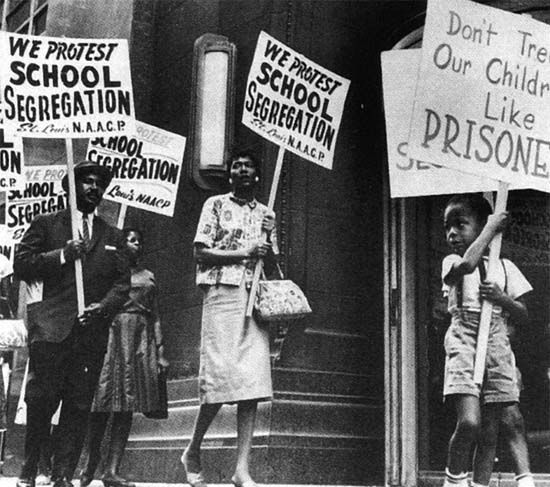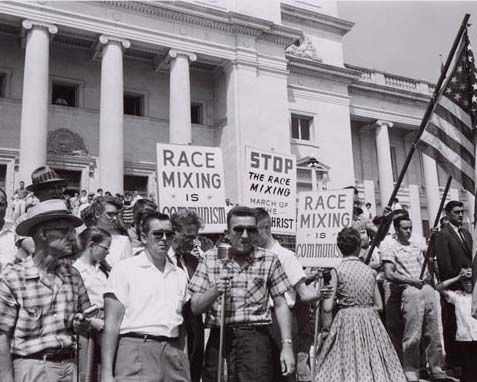Black Kos, Tuesday’s Chile
TUE OCT 22, 2013
E Pluribus…
de facto segregation
 Whether it was Cleveland or California, or busing in Boston, this country attempted to push forward on desegregation, and also put in place corrective measures of affirmative action.
Whether it was Cleveland or California, or busing in Boston, this country attempted to push forward on desegregation, and also put in place corrective measures of affirmative action.
The focus quickly shifted to de facto segregation of schools in major urban areas, like Chicago, where in 1963, two hundred twenty five thousand students boycotted Chicago, schools to protest de facto segregation on October 22nd. It was called “Freedom Day.” Kossak BobboSphere wrote an important piece on that protest against educational apartheid, and continues to follow closely community dissatisfaction with education policy and school closingsin communities of color.
A documentary record of Chicago’s Freedom Day, is a project put together on the protests.
63 Boycott chronicles the Chicago Public School Boycott of 1963 when more than 200,000 Chicagoans, mostly students, marched to protest the segregationist policies of CPS Superintendent Benjamin Willis, who placed mobile school units on playgrounds and parking lots as a “permanent solution” to overcrowding in black schools. The project will offer a modern perspective on the impact and legacy of this forgotten history 50 years later as it reconnects the participants to each other and the event itself.
Educators, parents, students and community groups across the U.S. don’t see any of this as ancient history, because no matter the advances, it becomes more and more clear each day that we still have racial/ethnic segregation in many of our public schools across the U.S. though now it is de facto rather than de jure.I’ve borrowed my title from the report issued last year, by the Civil Rights Project/Proyecto Derechos Civiles (CDP) “E Pluribus…Separation: Deepening Double Segregation for More Students“.
It opens with this overview:
This report shows that segregation has increased seriously across the country for Latino students, who are attending more intensely segregated and impoverished schools than they have for generations. The segregation increases have been the most dramatic in the West. The typical Latino student in the region attends a school where less than a quarter of their classmates are white; nearly two-thirds are other Latinos; and two-thirds are poor. California, New York and Texas, all states that have been profoundly altered by immigration trends over the last half-century, are among the most segregated states for Latino students along multiple dimensions.In spite of declining residential segregation for black families and large-scale movement to the suburbs in most parts of the country, school segregation remains very high for black students. It is also double segregation by both race and poverty. Nationwide, the typical black student is now in a school where almost two out of every three classmates (64%) are low-income, nearly double the level in schools of the typical white or Asian student (37% and 39%, respectively). New York, Illinois, and Michigan consistently top the list of the most segregated states for black students. Among the states with significant black enrollments, blacks are least likely to attend intensely segregated schools in Washington, Nebraska, and Kansas.
School resegregation for black students is increasing most dramatically in the South, where, after a period of intense resistance, strong action was taken to integrate black and white students. Black students across the country experienced gains in school desegregation from the l960s to the late l980s, a time in which racial achievement gaps also narrowed sharply. These trends began to reverse after a 1991 Supreme Court decision made it easier for school districts and courts to dismantle desegregation plans. Most major plans have been eliminated for years now, despite increasingly powerful evidence on the importance of desegregated schools.
The report does not spare the current administration and critiques wrong-headed policy.
The Obama Administration, like the Bush Administration, has taken no significant action to increase school integration or to help stabilize diverse schools as racial change occurs in urban and suburban housing markets and schools. Small positive steps in civil rights enforcement have been undermined by the Obama Administration’s strong pressure on states to expand charter schools – the most segregated sector of schools for black students. Though segregation is powerfully related to many dimensions of unequal education, neither candidate has discussed it in the current presidential race. The consensus of nearly sixty years of social science research on the harms of school segregation is clear: separate remains extremely unequal. Schools of concentrated poverty and segregated minority schools are strongly related to an array of factors that limit educational opportunities and outcomes. These include less experienced and less qualified teachers, high levels of teacher turnover, less successful peer groups and inadequate facilities and learning materials. There is also a mounting body of evidence indicating that desegregated schools are linked to important benefits for all children, including prejudice reduction, heightened civic engagement, more complex thinking and better learning outcomes in general.
They did however point towards solutions, and make policy recommendations, on Creating Awareness, Advocacy, Legal Enforcement, ending the list with Government Policies:
• The program of voluntary assistance for integration should be reenacted, building on the Obama Administration’s small and temporary Technical Assistance for Student Assignment Plans (TASAP) grant. The renewed program should add a special focus on diverse suburbs and gentrifying urban neighborhoods (which now normally fail to produce diverse schools).
• At the state level, recent developments in Ohio offer important lessons in how to create and sustain policy around the issues of reducing racial isolation and promoting diverse schools, such as how to create district student assignment policies that foster diverse schools, and inter-district programs like city-suburban transfers and regional magnet schools.
• At the regional level, the creation of regional magnets and regional pro-integration transfer programs, as is the case in Connecticut, could provide unique educational opportunities that would support voluntary integration. Providing funds for existing regional transfer programs such as METCO in the Boston area would be a positive step in the same direction.
This situation does get media coverage, with headlines popping up around the nation:(Maryland) De facto segregation threatens Montgomery public schools
(Texas) Breaking News: School Segregation Study Strikes A Nerve
(New York) A Portrait of Segregation in New York City’s Schools
alJazeera America recently did a comprehensive feature piece “Six decades after Brown ruling, US schools still segregated“
There are books, studies, and conferences, combined with community activism. Yet it has not caught the public imagination as a goal for all Americans.
I appreciated this thoughtful commentary by Rhena Catherine Jasey, Still Separate and Unequal:
It is disappointing and surprising that so many people seem blind to the current state of affairs in public education. Many deny that the inequalities that exist between the children of middle and upper-middle class parents and their poorer counterparts is an issue of justice. Some claim that the issue is “cultural”, a capacious word used in this case to mean “futile.” Whatever the silent assumptions lurking in the background, the fact is that few not already engaged in addressing the problem feel much motivation to do anything about it. There is certainly no sense of urgency among the general public, or in our political class as a whole, about addressing the current state of public education in our cities. It is instructive to compare this widespread apathy with the dramatic activism that in past decades overcame other societal injustices. We have seen, for example, remarkable shifts in public opinion, and in the application of our concepts of justice and equity, with respect to the handicapped. Our society and government have also reacted vigorously to the perils of second-hand smoke. We have come a long way in a short time, and spent billions and passed many laws, when it came to creating and enforcing new behavioral norms to protect the environment. The sense of the public welfare has been so strong in these areas that the public will has developed to pursue initiatives that benefit society notwithstanding the fact that the benefits may not correlate with the population making the bulk of the sacrifice. What has applied in those cases applies as much as, if not more, to the task of providing a more equitable educational experience for poor urban and rural children: Everyone would gain. This is not charity but self-interested social investment. How do we explain the lack of public ardor for fixing our educational inequalities?
Consider the following thought experiment. Imagine a society in which every child has exactly the same chance of being placed in any of our public schools, regardless of income level or zip code. Children would no longer simply be sent to their local school; instead, all children’s names in a particular geographical area would be collected in a hat and picked at random for assignment to a given school. In this imaginary world, a child born into a family living in a middle or upper-middle class area could be sent to a school in a poor urban or rural environment. Similarly, a child born into a family living in poverty could be bound for one of the best schools in the nation. Everyone’s odds would be equal
I have no children. But I benefited from a high quality public education, and would like to see that privilege extended to young people across the U.S. who will inherit the world so many of us fought so hard to change in the 60’s and 70’s. The struggle continues.
>via: http://www.dailykos.com/story/2013/10/22/1248974/-Black-Kos-Tuesday-s-Chile


